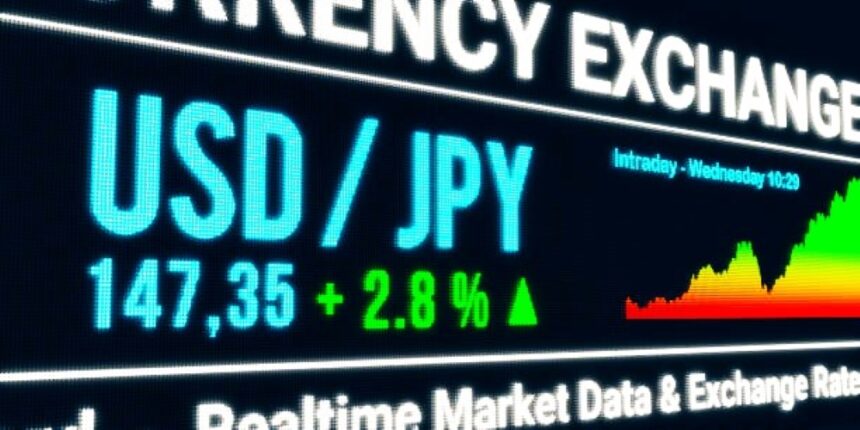Japanese Yen Struggles Amid Trade Concerns & Risk-On Sentiment
The Japanese Yen (JPY) has been on the back foot for the second consecutive day, with the USDJPY pair climbing above the 148.00 mark. Several factors are influencing the Yen’s weakness, including concerns about US trade tariffs on Japan and an overall improvement in global risk sentiment.
Investors are closely monitoring potential trade policies under former US President Donald Trump, as he has hinted at imposing fresh tariffs on Japan. If these trade barriers materialize, Japan’s economy could face challenges, putting additional pressure on the Yen.
At the same time, a risk-on mood in global markets is reducing demand for the safe-haven JPY. When investors feel optimistic about economic growth, they typically shift towards riskier assets, leaving defensive currencies like the Yen weaker.
BoJ Rate Hike Speculation Supports Japanese yen
Despite the recent dip, the Yen remains relatively stable due to rising expectations of further rate hikes by the Bank of Japan (BoJ). Japan has been experiencing persistent inflation, and the central bank is expected to respond with more monetary policy tightening.
Recent economic data released in Japan further fueled rate hike speculation. The Producer Price Index (PPI)—which tracks wholesale inflation—increased by 4.0% year-on-year in February. While this was slightly lower than the previous month’s 4.2%, it still indicates that inflationary pressures are present.
For nearly three years, Japan’s consumer inflation has exceeded the BoJ’s 2% target. The central bank is under pressure to gradually shift away from ultra-loose monetary policy and introduce rate hikes to keep inflation in check. This expectation is preventing the Yen from experiencing steep depreciation despite its recent weakness.
Wage Growth Could Influence BoJ Policy
Another critical factor supporting a hawkish BoJ stance is the potential for higher wages in Japan. Large corporations are expected to continue offering substantial wage hikes for the third consecutive year.
Higher wages are crucial for consumer spending and economic growth. If wages rise at a steady pace, Japanese households will have greater purchasing power, which could fuel further inflation. This scenario makes it more likely for the BoJ to tighten its policy further in the coming months.
BoJ Governor Kazuo Ueda recently commented on the rise in long-term interest rates, suggesting that the central bank’s outlook aligns with market expectations. This means that Japan’s monetary policy trajectory is shifting towards more tightening, supporting the Yen in the long run.
US Dollar Faces Pressure from Rate Cut Expectations
While the Japanese Yen is under short-term pressure, the US Dollar (USD) is also facing challenges due to growing expectations of Federal Reserve (Fed) rate cuts in 2024.
Market participants are currently pricing in at least three rate cuts of 25 basis points each by the Fed before the end of the year. These expectations were reinforced by the latest US Nonfarm Payrolls report, which showed signs of a cooling labor market.
A weaker labor market raises concerns about slower economic growth in the US, increasing the likelihood that the Fed will ease its monetary policy. If interest rates in the US decline, the USD could weaken further, which might provide some relief to the Yen.
Key Factors Influencing USDJPY
Several factors are driving the USD/JPY exchange rate in both directions:
1. BoJ Rate Hike Expectations: Japan’s inflation trends and potential wage growth support further tightening.
2. US Rate Cut Speculation: The Fed is expected to cut rates due to a weakening labor market, weighing on the USD.
3. Global Risk Sentiment: A risk-on mood weakens demand for safe-haven assets like the Yen.
4. Trade Tariff Concerns: Uncertainty around Trump’s potential tariffs on Japan is keeping the JPY under pressure.
5. Bond Yield Movements: Japan’s 10-year bond yield is near its highest since 2008, while US bond yields are trending lower.
Japan’s 10-Year Bond Yield Nears 16-Year High
One of the most significant market developments is the rise in Japan’s 10-year government bond yield, which remains close to its highest level since October 2008. This suggests that investors expect higher interest rates in Japan moving forward.
In contrast, US Treasury bond yields are declining as traders anticipate softer monetary policy from the Fed. This divergence in bond yields is another factor that could help limit further JPY depreciation against the USD.
US Inflation Data Could Trigger Volatility
Looking ahead, traders are awaiting the US Consumer Price Index (CPI) report, which is scheduled for release soon. This report will provide crucial insights into inflation trends in the US and could have a major impact on the Fed’s policy outlook.
If the CPI data comes in stronger than expected, it could delay Fed rate cuts, providing support for the USD. On the other hand, weaker inflation data could reinforce expectations of a dovish Fed, leading to further USD weakness.
Given the importance of this data, investors are likely to stay cautious before taking significant positions in the USDJPY pair.
What’s Next for USDJPY?
The short-term outlook for USDJPY remains uncertain due to conflicting forces. However, some key scenarios could play out:
If the BoJ remains hawkish and inflation stays high in Japan, the Yen could strengthen, pushing USDJPY lower.
If the Fed signals more aggressive rate cuts, the USD could weaken further, benefiting the Yen.
If global risk appetite continues to rise, demand for the safe-haven JPY could decrease, keeping USDJPY elevated.
If Trump moves forward with trade tariffs on Japan, the Yen could face further downside risks.
Conclusion
The Japanese Yen is currently facing short-term weakness against the USD, but expectations of further BoJ rate hikes are preventing significant depreciation. Concerns over US trade policies and a positive risk sentiment are weighing on the JPY, while Japan’s inflation trends and rising bond yields are offering support.
At the same time, the US Dollar is struggling due to growing Fed rate cut bets, and upcoming inflation data will be a key driver of market sentiment. Traders will likely remain cautious until clearer signals emerge from central banks regarding their monetary policy direction.
In the coming weeks, USDJPY will remain highly sensitive to global economic developments, especially BoJ rate hike signals, Fed policy expectations, and US inflation data. Traders should keep an eye on these factors to make informed decisions.









